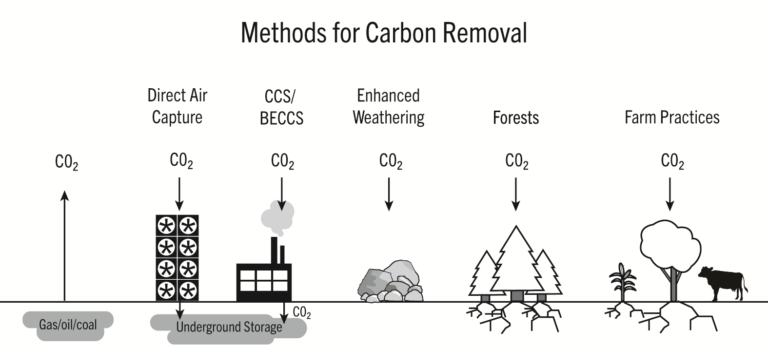
Carbon Removal

In this final chapter, we will shift our attention to methods of actively removing carbon from the atmosphere. As previously discussed, removing carbon is necessary because emissions reduction alone is no longer enough to keep warming below 1.5 ºC.[1] Two approaches are currently available. First, forests can be expanded and natural, sustainable practices can make existing forests, farms, and grasslands into better carbon sinks. Some of these practices are well established and able to significantly slow temperature increases over the next few decades. Second, there is potential for entirely new industries to extract carbon dioxide from the air and bury it safely underground. Here, substantial development is still needed before the technologies are workable and cost-effective on a larger scale. The natural and industrial undertakings are necessary and urgent, both deserving of more attention than they presently receive.[2] As in many other areas, a big part of our work as advocates is to increase the political will to engage the problem.
Both natural land management and technology-based carbon removal enjoy bipartisan support. For example, in March 2019, large majorities in Congress passed the National Resources Management Act—a comprehensive bill that protects many forests and wilderness areas while also offering better access for hunting and fishing.[3] The Great American Outdoors Act, which funds the National Park system along with a host of conservation and recreation programs, was recently passed with similar support.[4] In both cases, diverse interests came together because the bills’ language emphasized conservation and sustainable use—without dwelling on climate change. For climate advocates, the key was to find common ground with interest groups that had their own reasons to protect the land. A broad constituency also supports new technologies for carbon removal, because these carbon capture methods that can profitably reduce emissions from existing industries are also adaptable for large-scale carbon drawdown.
The Carbon Removal Challenge
Carbon removal takes us back to the principles of how human activity affects the carbon cycle.[5] Let’s recall that deforestation and changes to soil structure from industrial agriculture remove stable carbon sinks, so more carbon dioxide stays in the atmosphere. Part of our task is to undo this damage by reversing the process, planting new forests, and adopting practices that sequester more carbon on the land.
A common stance among climate advocates is that natural land management alone can restore a healthy carbon balance. This is understandable since it appears to be much more Earth-friendly than building out new industrial infrastructure. But the problem is that land use change accounts for just 30 percent of the cumulative increase in carbon dioxide levels.[6] And because the natural capacity of the land to absorb new carbon is limited, it is unable to also take up the additional carbon dioxide from fossil fuel burning and cement manufacture. So far, only the oceans—Earth’s other large carbon sink—have been able to absorb atmospheric carbon dioxide in proportion to the increasing emissions.[7] However, many climate scientists think that, in time, the oceans will also become unable to maintain a high rate of carbon uptake. For these reasons, both natural land management and industrial-scale carbon removal are necessary.
Collectively, the methods for atmospheric carbon removal are called negative emissions technologies. They are the only way to reduce carbon dioxide concentrations to safe levels and will likely also be needed to compensate for residual greenhouse gas emissions that can’t be eliminated by any other approach. We must recognize at the outset, however, that investing in negative emissions technologies does not justify reducing other efforts. Clearly, the higher we allow carbon dioxide levels to go, the greater the chance of passing one or more irrevocable and potentially catastrophic climate tipping points.[8] So the best approach is all of the above, with emissions reduction and atmospheric carbon removal each receiving attention. The need for rapid action on carbon removal is further underscored by the fact that some of the new technologies will take decades to develop.[9]
Let’s look at some of the numbers. Climate models tell us that, to achieve a 1.5 ºC world, we must deploy enough negative emissions technology to reduce the carbon dioxide concentration below 2016 levels (403 ppm) by 2100.[10] In this best-case scenario, carbon dioxide levels would plateau at about 450 ppm in two or three decades before declining. Whether this aspiration is feasible depends on two things: the potential for negative emissions technologies to remove the carbon, and the capacity of underground reservoirs to safely sequester it indefinitely.
Fortunately, it appears possible to satisfy both requirements. Climate models for 1.5ºC worlds project that, by 2050, 5–15 billion gigatons of carbon dioxide (GtCO2) will have to be removed from the atmosphere each year.[11] Today, we have built the capacity to capture only about 1 percent of that,[12] but the buildup to necessary levels is feasible. The best estimates of plausible annual carbon removal by 2050 in the US alone are 0.5–2.85 GtCO2, a significant part of the global requirement.[13]
Carbon dioxide is best sequestered in suitable underground geological formations, which are abundant. Estimated US storage capacities range from 1500–2000 GtCO2 to nearly 15,000 GtCO2.[14] Although safety concerns have yet to be fully addressed, there is no shortage of space to store the carbon.
Climate-sustaining atmospheric carbon removal is an enormous project and will be one of humanity’s great undertakings. We can start immediately, by expanding effective and already available approaches in agriculture and forestry. In fact, almost all progress in the next decade will likely come from natural land management—especially tree restoration. Large-scale carbon removal needs more development, including an infrastructure buildout driven by more application of carbon capture and storage (CCS) in industries like cement manufacturing and steelmaking. To realize our climate goals, the new technologies may eventually need to bear a larger share of the burden,[15] and that will depend on how aggressively greenhouse gas emissions are reduced over the next few decades.
[1] See Chapter 3 and the Interlude for a full discussion.
[2] G.F. Nemet et al., “Negative Emissions—Part 3: Innovation and Upscaling,” Environmental Research. Letters, 13 (2018), https://iopscience.iop.org/article/10.1088/1748-9326/aabff4/meta
[3] For a summary of the National Resources Management Act, see https://www.energy.senate.gov/public/index.cfm?a=files.serve&File_id=6AE823EB-7FE1-42BF-987E-A2234BAEA46F. The bill passed with a 92-8 majority in the Senate and 363-62 margin in the House.
[4] Dan Harsha, “The Biggest Land Conservation Legislation in a Generation,” The Harvard Gazette, July 27, 2020, https://news.harvard.edu/gazette/story/2020/07/the-likely-impact-of-great-american-outdoors-act/
[5] See the discussion in Chapters 1 and 2.
[6] See Figure 3-3.
[7] Nicolas Gruber et al., “The Oceanic Sink for Anthropogenic CO2 From 1994 to 2017,” Science no. 363 (2019): 1193-1199, https://science.sciencemag.org/content/363/6432/1193?rss=1. Of course, this CO2 uptake comes with the high price of acidification (see Chapter 4).
[8] See Chapter 4 for a discussion of tipping points.
[9] For a comprehensive analysis of how long it may take to establish negative emissions technologies at a large scale, see G.F. Nemet et al., “Negative Emissions—Part 3: Innovation and Upscaling,” Environmental Research. Letters no. 13 (2018), https://iopscience.iop.org/article/10.1088/1748-9326/aabff4/meta.
[10] Rogelj, “Mitigation Pathways Compatible with 1.5°C in the Context of Sustainable Development.” In: Global Warming of 1.5°C. An IPCC Special Report on the impacts of global warming of 1.5°C , 101.
[11] See Chapter 1 for a discussion of the gigaton unit. For comparison, in 2019 worldwide carbon dioxide emissions from fossil fuels and the industrial sector were 37 GtCO2, while the estimated contribution from human land use change was an additional 6 GtCO2. Sabine Fuss et al., “Negative Emissions—Part 2: Costs, Potentials and Side Effects,” Environmental Research Letters no. 13 (2018): 4, https://iopscience.iop.org/article/10.1088/1748-9326/aabf9f/meta.
[12] Global CCS Institute, Global Status of CCS 2020, at p. 13. This report is available at https://www.globalccsinstitute.com/resources/global-status-report/
[13] James Mulligan et al., “CarbonShot: Federal Policy Options for Carbon Removal in the United States,” World Resources Institute, (2020); 3, https://www.wri.org/publication/carbonshot-federal-policy-options-for-carbon-removal-in-the-united-states
[14] Howard Herzog, Carbon Capture, (Cambridge: MIT Press, 2018), 84.
[15] James Mulligan et al., “CarbonShot: Federal Policy Options for Carbon Removal in the United States,” World Resources Institute (2020): 10, 12, https://www.wri.org/publication/carbonshot-federal-policy-options-for-carbon-removal-in-the-united-states
